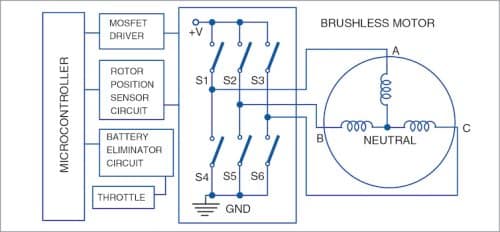ESC, or electronic speed control, is a circuit used to change the speed of an electric motor. There are two types of ESCs—brushed and brushless. Brushed ESC is used for a brush motor, brushless ESC is used for a brushless motor. Depending on the type, their construction and design are different. Brushless ESCs are more advanced and costly than brushed ESCs.
The construction of most ESC modules includes a power supply stage, a current-sensing circuit, a controller, and a communication interface. In order to design an ESC, you need to know the position of the rotor. There are two common methods used for determining the rotor position—Hall-effect sensors embedded in stator and sensing the back electromotive force from motor. The ESC is used to capture these signals.
The design and construction of brushless ESC can be done using 3-phase bridge drivers such as IRS2330, L6234, or microcontrollers. Designing an ESC for drones requires high-quality components that are designed to control high-RPM motors. There are some microcontrollers specifically designed for such applications. For example, Texas Instruments has a family of MCUs, called InstaSPIN, that simplify the design of three-phase motor control applications. STMicroelectronics offers a complete ESC reference design, implementing a sensorless FOC (field-oriented control) algorithm.
Most of the modern electronic speed controllers include a microcontroller to process the input signal and control the electric motor through an inbuilt program. A simplified ESC block diagram is shown in Fig. 1.





